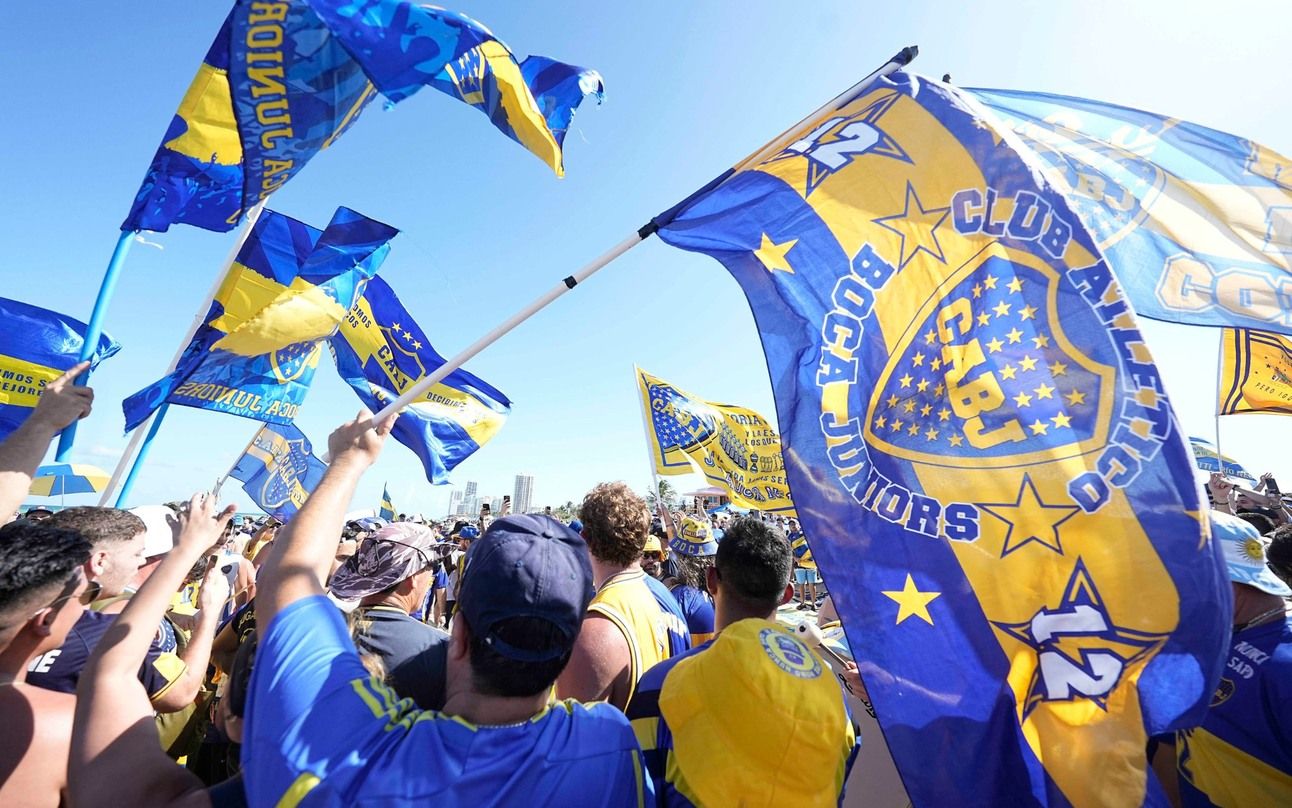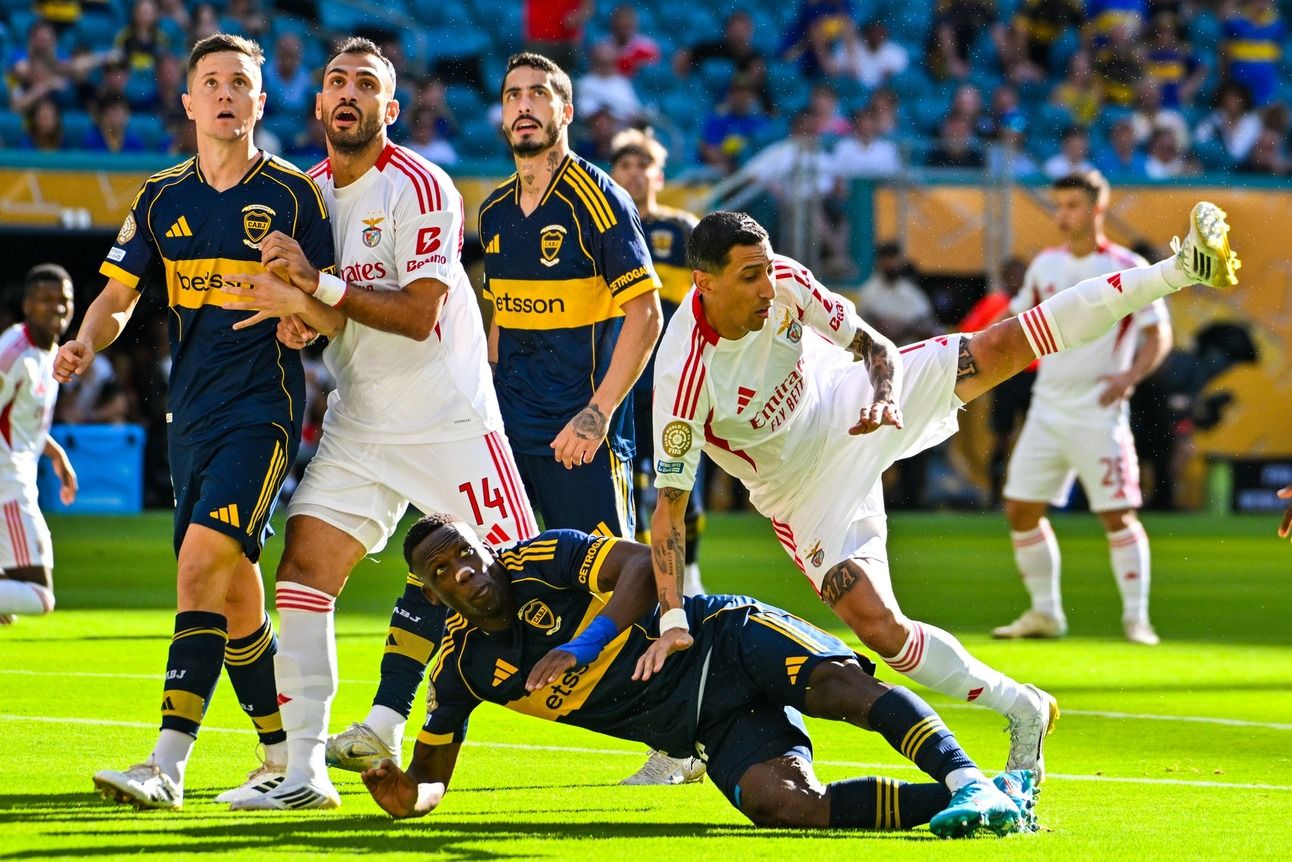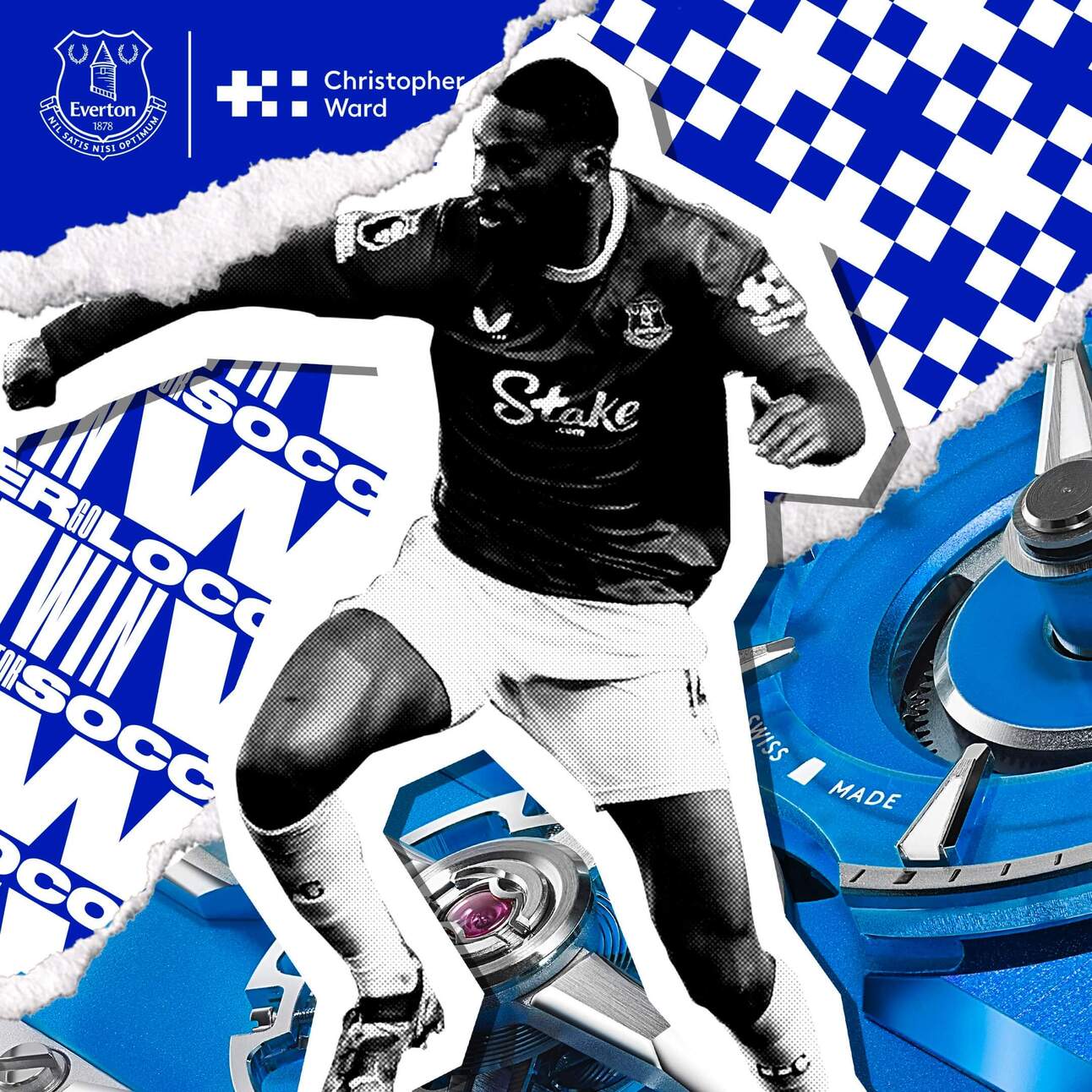- The Raven
- Posts
- A Blast of Authenticity at the Club World Cup 🎉
A Blast of Authenticity at the Club World Cup 🎉
Rory Smith on South American and North African fans bringing the noise, the rough history of international club tournaments, and the best gelato... on Earth?
Greetings from Yorkshire!
Rory Smith writes: I’m writing to you while watching Real Madrid huff and puff against Al Hilal in both teams’ opening games of the Club World Cup. From a distance, admittedly – my spell at the tournament starts in the quarterfinals – but that does mean I can confirm this game has worked for me as a television spectacle. It’s not been a classic, necessarily, but it’s been intriguing, and that’s something.
That hasn’t been true of every game at the tournament. The opening match finished goalless, a potent reminder of the eternal truth that soccer is, ultimately, going to soccer. Bayern Munich’s 10-0 win against Auckland City did nobody any favors. But then Boca Juniors against Benfica was great. PSG’s win against Atlético Madrid was imposing. Monterrey and River Plate added to the general gaiety. I thought LAFC emerged from its game with Chelsea with credit.
The real stars of the Club World Cup so far, though, have been roughly the same people who tend to play that role at more familiar World Cups. That’s what this week’s edition of the newsletter is about: the bands of fans who make these tournaments work.
Enjoy,
Rory
A Blast of Authenticity in a Carnival of the Ersatz 🎉

The giant thumb had a kind of magnetism. Nobody was quite sure why it was there. It was never really explained what it was supposed to symbolize. Approval, maybe? Life, in the way that a Roman Emperor might have understood that gesture? An unexpected but not unwelcome reminder of the Fonz? It didn’t matter. Sooner or later, everyone found themselves drawn to the giant thumb.
The thumb in question was a sculpture, either made out of gold or plated with it, and placed in one corner of the main intersection in Souq Waqif, Doha’s small but suspiciously perfectly formed marketplace. It had, presumably, been designed and installed specifically for the 2022 men’s World Cup; even if it had not, it soon became an icon of the tournament.
With every day that passes between now and that World Cup, it comes to feel more and more like a kind of fever dream. That month or so in Qatar was profoundly uncanny: a Potemkin tournament that blurred the lines between the real and the fake so thoroughly that they dissolved into nothingness.
Ghostly music emerged from the streets. There was a building that looked like a Stargate. There were fans who were, in effect, hired actors. The size of the stadiums changed overnight. A giant shark floated in the air. The World Cup final – maybe the best World Cup final – was held in a city that did not, in any meaningful sense, exist.
Even the Souq was not quite what it seemed. That was where the marketplace had been, before its deposits of natural gas made Qatar one of the richest places on the planet: this had always been Doha’s Souq. But it had been rebuilt over the years, so as to look exactly like a Souq should look, and to function just slightly better than most Souqs actually function. It had been designed to look faded, but artfully so; to seem chaotic, but in an ordered sort of a fashion.
The whole tournament, the whole place, felt so artificial that the real became intensely precious. And that is what brought everyone to the giant thumb.
FIFA, and the local organizing committee, had not really intended for the Souq to serve as the tournament’s primary meeting place – it was only a few days after the start of the tournament that they started running announcements on Doha’s pristine metro directing people towards it – but the fans decided, en masse, that it was going to be.
Every day, they came in their thousands, heading for that main intersection, gathering just in front of the thumb. It changed every few minutes: one moment it was a mass of Argentinean blue and white, flags bearing the faces of Diego Maradona and Lionel Messi; the next it was filled with the bright red banners of Tunisia or Morocco; and then it was all yellow and blue and red as the Colombians or Ecuadorians appeared. The Souq became the heartbeat of the World Cup, a little island of the real in a sea of the ersatz.
I’ve been reminded of that several times in the opening days of the Club World Cup, as images of Boca Juniors fans occupying Miami Beach – “storming it,” as my friend James Horncastle put it – or Fluminense supporters massing in Times Square or Wydad Casablanca ultras marching through Philadelphia have appeared on social media.
PALMEIRAS FANS TAKE OVER THE BROOKLYN BRIDGE 💚
After taking over Times Square earlier this week, the Brazilian fans have now crossed the East River. What borough is next?
— Men in Blazers (@MenInBlazers)
3:09 AM • Jun 19, 2025
The Club World Cup might be a construct. It might be an idea that sprang, if not fully formed then certainly half baked, from the brain of Gianni Infantino. It is by its very definition artificial, in the way that all sports tournaments are artificial when they first start. It is, in its genesis, deeply craven and undeniably venal and moderately troubling.
Just as in Qatar, that has only served to accentuate those elements of it that are truly, undeniably, refreshingly real. And there is, ultimately, nothing more real than the fervor and the passion of those fans – particularly from South America and North Africa – who have either followed their teams to the United States or have previously been transplanted there and now gleefully embraced the chance to express their support.
The more commercialized soccer becomes, the more intensely the sport sells itself to the highest bidder, the more determined it becomes to bleed itself dry, the more power the noise and the color and the vibrancy of those fans seems to possess. That total devotion, that adoration that can transport people across continents, is the one thing that remains somehow pure, unspoiled.
It may well be the case that the first edition of the Club World Cup will, in the end, be a distinctly European affair. The chances are that the quarterfinals, at the very least, will have a very Champions League sort of feel. But while it might be European teams that will end up winning the tournament, it will be the South American and North African fans who made it.
Excited for the 2026 World Cup? Our weekly USMNT Only newsletter is your go-to source for backstories, insights and narrative surrounding Poch’s squad in their run to (hopeful) glory. Subscribe now. 🇺🇸
Maintaining Tradition 🩼

Boca Juniors took a notably – let’s be diplomatic here – robust approach to its opening game against Benfica. Carlos Palacios, Rodrigo Battaglia and Alan Velasco all made at least one wince-inducing challenge in the first half alone; the foul for which Jorge Figal was sent off late in the second was the sort of red card which even Arsenal fans would struggle to bemoan. In between, Ander Herrera saw red, too, for wrestling a security guard.
This might not be the sort of entertainment that FIFA wants to use to promote its shiny new tournament, but it does at least bond the expanded Club World Cup to previous versions of the competition. In its early years, when it was a two-legged game between the champions of Europe and the champions of South America, the Intercontinental Cup final was notoriously violent.
In 1967, a meeting between Argentina’s Racing and Scotland’s Celtic was so notoriously bad-tempered that the latter’s manager, Jock Stein, walked onto the field to complain to the referee. In 1968, Matt Busby, the Manchester United manager, demanded Argentine club sides be banned wholesale because of the, um, ‘physical’ style of Estudiantes de La Plata.
His call was ignored, and in 1969 Estudiantes were back, playing AC Milan, in a game which involved biting, punching and at least one player being arrested for draft-dodging while on a stretcher. By 1971, Ajax felt so strongly about it that the club just refused to play in the game. They did the same in 1973. Liverpool declined to take part in 1977 and 1978, while Nottingham Forest swerved it in 1979. Thinking about it, maybe this is why FIFA was so keen to make the prize money for the new version so eye-watering. It might be worth being kicked around a bit to win $100 million, after all.
The World’s Best Ice Cream 🇦🇷🍦
I have never been tempted to resort to violence at Rapa Nui, an ice cream store in the upmarket Palermo neighborhood in Buenos Aires, but I would consider it if it looked like they were running out of Dulce de Leche. I am slightly reluctant to go this big this early, but as far as I can tell – and I really cannot stress how much research I have done on this subject – Rapa Nui does the best gelato in the world. This isn’t necessarily the sort of thing I’d say out loud in Italy, but it doesn’t mean it isn’t true.

U.S. Soccer Fans: Win a VIP Football Experience! 💙
Whether you call it soccer, football, or fútbol – if you’ve gone the distance for your team, we want to hear about it. Missed a wedding to be at the game? Homemade banner specialist? Tell us your story. As Global Timing and Shirt Sleeve Partner of Everton Football Club, Christopher Ward is giving away a VIP soccer experience to one U.S. fan who’s gone the extra mile for the club they love. One lucky winner will receive a money-can’t-buy experience for two in Atlanta, Georgia from August 1-3, including tickets to Everton vs. Manchester United, the chance to watch first-team training, a signed Everton shirt, breakfast with a former player, included US travel and accommodation, and more.
What I’ve Been Writing ✍️
Europe might feel a little above the Club World Cup, but soccer really isn’t just about Europe.
The new breed of TikTokified Influencer leagues might look like novelty acts, but there is a sustained challenge to the established order of sport going on, and that’s worth taking seriously.
And those two stories sort of met in the middle, when it occurred to me that what separates sport from content is the possibility that the opening game of your shiny new tournament will finish goalless.
And What I’ve Been Reading 📚
I’ve no idea if the reality series “Love Island” has made it across to the U.S., but it is now Britain’s dominant form of cultural expression.
Sports show that we all have different tolerances for risk, especially as society becomes more safety-conscious.
And where does a 24-hour rolling news channel go when we all carry 24-hour rolling news channels in our pockets?
Any Further Business 🏛️
Thanks to Christopher Johns, of parts unknown, for an email that was brief and to the point. “We are heading to Greece next month, and desperately need dining recommendations in Athens.” This is precisely the sort of public service journalism this newsletter thrives on. First of all: Don’t feel like it’s gauche to eat in Plaka. Yes, it’s touristy. But touristy places tend to be touristy for a reason. My favorite parts of the city, though, are Psirri (which I may not be spelling correctly) and Monastiraki. Kalimeres is peaceful and artsy. Morenita is quite cool. And Maiandros, not far from Monastiraki metro station, is simple but gets you to where you need to be. Have a great time!
That’s all for this week. Thanks so much for reading, and for listening. And remember: if you would like a restaurant recommendation for a European (and maybe South American) city, feel free to drop a note to [email protected]. The same system applies if you’d like to talk about any aspect of soccer.
Rory
